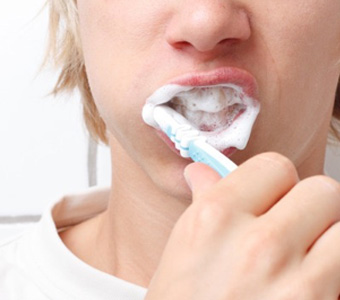Table of Contents
Have you ever taken a close look at the ingredients listed in your toothpaste? There is one ingredient, in particular, that’s causing concern amongst leading scientists including David Suzuki and it may be doing you and your children harm . Sodium Lauryl Sulfate is a chemical listed as an ingredient in personal hygiene products found in the family home. TO Avoid SLS and other harmful additives, a natural toothpaste is recommended.
In the following article, we’ll take a closer look at SLS, and it’s potential dangers. We’ve also listed a number of natural toothpaste alternatives free of chemicals such as SLS.
Is your toothpaste harming you?
Sodium Lauryl Sulfate is a surfactant. What’s this you ask? To keep things simple let’s just say it breaks surface moisture tension. Surfactants also increase the ‘foaminess’ we associate with products such as toothpaste and soap. SLS is also an ingredient in many industrial cleaning products such as detergents and degreasers. Natural toothpaste
Links to Cancer?
There are some who claim that SLS causes Cancer. While many share this concern, it’s important to note that there is no scientific basis to verify this assertion. In fact, even the American Cancer Council dispute that SLS is a cause of Cancer . (*This article has since been removed from the American Cancer Council website).
The problem with unsubstantiated claims made against SLS is that substantiated health implications don’t get a lot of attention. In the case of SLS, this applies in particular if you have skin that is sensitive and prone to irritation. Those who suffer canker sores, for instance, benefit by switching to SLS-free toothpaste.
What’s the difference?
 In most cases, the real difference is the amount of foam produced by the cleaner. As natural cleaning products do not use a surfactant, there isn’t as much foam produced. Despite the lack of foam in most cases, the alternative product can be just as effective. There is also the question of taste. Many people consider organic toothpaste not as appealing.
In most cases, the real difference is the amount of foam produced by the cleaner. As natural cleaning products do not use a surfactant, there isn’t as much foam produced. Despite the lack of foam in most cases, the alternative product can be just as effective. There is also the question of taste. Many people consider organic toothpaste not as appealing.
In our testing, we have found that no two SLS free products taste the same. If you are considering a change, don’t ignore all natural options if you have only sampled one. Finding a suitable alternative may take some trial and error.
SLS and children?
Here’s where things can get interesting. Children often have sensitive skin. Younger children also have a penchant for putting anything in their mouths. Unfortunately, this includes shampoos, soaps and of course toothpaste. As a result, it is a good idea to try an SLS free product for children if you are experiencing issues such as skin and gum irritation. Sodium Lauryl Sulfate can cause problems with kids’ delicate skin. If ingested, it can also irritate the throat which can lead to respiratory issues.
Companies that make natural toothpaste
As you may guess, production costs are generally behind why manufacturers use products such as SLS. Manufacturers are often forced to produce cost effective products as we demand them. So using low-cost ingredients to make their products is not exactly newsworthy.
But, some toothpaste manufacturers refuse to use SLS in their products. They may cost a little more, but reduce the risk of canker sores and other gum diseases associated with SLS. The following are a few of the more popular brands you can buy at your local health store:
- [easyazon_link identifier=”B00JUJ1BCS” locale=”US” tag=”hfs00-20″]Tom’s of Maine[/easyazon_link]
- [easyazon_link identifier=”B000IBNR5G” locale=”US” tag=”hfs00-20″]Jason Personal Care[/easyazon_link]
- [easyazon_link identifier=”B0054LHI5A” locale=”US” tag=”hfs00-20″]Burt’s Bees[/easyazon_link]
- [easyazon_link identifier=”B001OOLF82″ locale=”US” tag=”hfs00-20″]Sensodyne Pronamel[/easyazon_link]
- [easyazon_link identifier=”B0036ZA40W” locale=”US” tag=”hfs00-20″]Dr. Collin’s[/easyazon_link]
Many of these manufacturers use alternative natural ingredients. Alternative ingredients include Tea Tree Oil (fights bacteria) and Xylitol (reduces cavities).
Homemade Toothpaste
It’s convenience that drives people to buy the manufactured toothpaste alternatives. But for those of us who want to save a few dollars and make a simple natural alternative, it’s not all that difficult.
How to Make Natural Toothpaste
- 2/3 cup of baking soda
- 2-tsp. (or 15 drops) of peppermint or spearmint extract
- Filtered water (distilled is better)
- Salt (optional)
Method
It’s quite simple and only takes around ten minutes to complete. First, you will mix the ingredients together, with the only variable being water. The amount of water mixed in with the other ingredients is up to you. For a thicker mixture add less water, for a more fluid mixture add more water. In most cases start with only a small amount of water and add more as you go.
The Baking Soda Myth.
Some people think baking soda is abrasive. As a result, they believe it can cause damage to the enamel on your teeth. The truth is, using a hard bristled brush and grinding the bristles against your teeth do damage. Baking soda is an alkaline, so it helps reduce the risk of plaque and bacteria.
Cost
The cost of making natural toothpaste is around .75 cents. You can compare this price to a 5.2-ounce tube of toothpaste. The toothpaste mentioned above cost between five to six dollars.
Summary
Finally, a word of caution, some natural alternatives taste pretty damn awful. In fact, if you plan on encouraging your children to use an organic toothpaste it can be difficult.
It’s worth trying different manufacturers, as some e.g. Tom’s of Maine are more accepted than others. Some manufacturers such as Jack and Jill Kids produce natural toothpaste for children.
